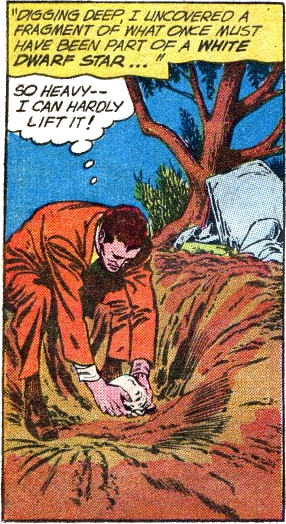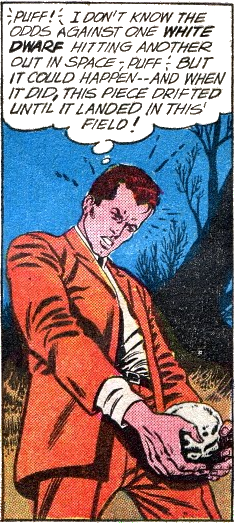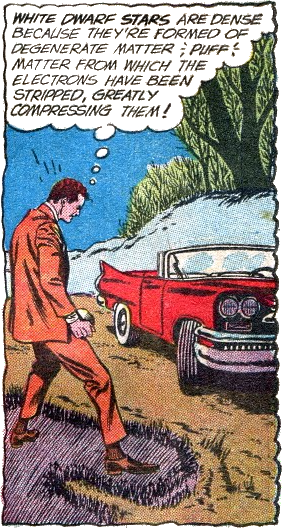Degenerate Matter
Tuesday, 1 June 2010At Kingdom Kane (a 'blog focussed upon the art of Gil Kane), Mykal Banta has reproduced The Birth of the Atom
. a story which contains what I have long regarded as an epitomal sequence of what I call comic-book science
: 



As I noted to Mykal, a white dwarf star has a density of about 1 million grams per cc, and the meteor appears to be about 1000 cc, so the whole thing should mass at about 1 million kilograms.
It's not apparent why 1 million kilograms should stay compressed into such a small volume. In the case of a dwarf star itself, the gravitational mass of the star as a whole creätes sufficient force, but this is just a fractional piece of such a star. It ought to fly apart as a terrible burst of radiation. But let's assume that this somehow doesn't happen, that the meteor just stays together in a nifty one-liter piece.
The meteor that creäted Meteor Crater in Arizona was under 30,000 kilograms. Ray wouldn't be excavating the meteor at all; he would have been killed by the shock waves from the impact. Those who later did excavate the meteor wouldn't find it buried just a couple of feet deep.
At the surface of the Earth (which itself masses about 5.97 × 1024 kilograms), this meteor would weigh about 11 hundred tons, but Ray picks it up! He subvocalizes a few puffs, but he manages to carry the thing back to his car! Now-a-days, they don't make cars that can carry 11 hundred tons. I don't think that any grad students can lift 11 hundred tons. And, really, Ray ought to be sinking into the ground, as even if he has big feet and has both feet on the ground he is applying over 7000 kPa of pressure to the soil.
It might be suggested that the meteor, while perhaps of material that were once compressed to a density of about 1 million grams per cc, were subsequently uncompressed, and that what Palmer recovered were only, say, 100 kilograms of material. But I don't know how, then, it would be recognizable as originating from a white dwarf star. For example, the core of the sun compresses matter to a greater density than 100 grams per cc.


